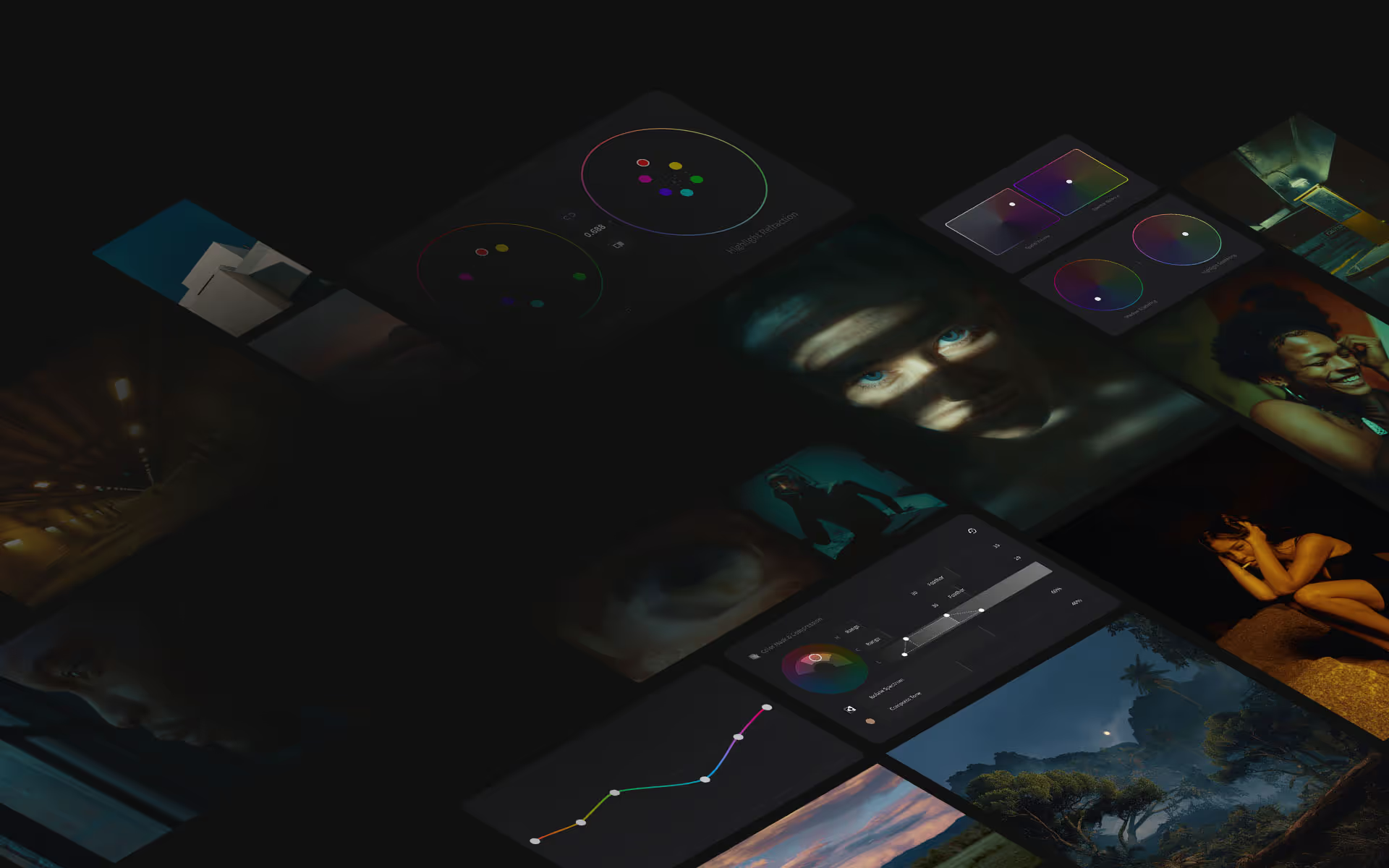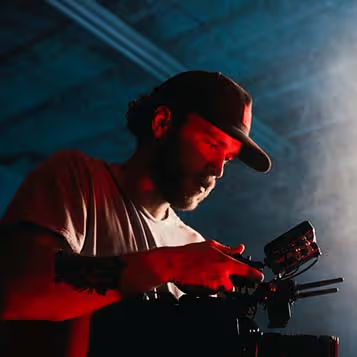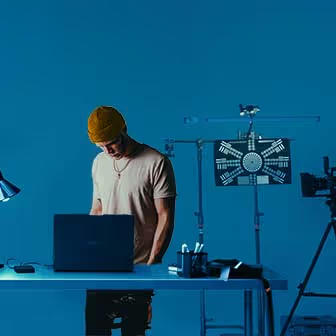
AI Powered RAW Image Processor And 3D LUT Creator
The App for Color-Obsessed Photographers & Filmmakers.
Color.io is an online RAW image processor and best-in-class 3D LUT creator that helps photographers and filmmakers create stunning color for their images.

All-in-one raw photo developer, film emulator and 3D LUT creator.
One-of-a-kind color modelling that simulates the light response of film. Embedded in an intuitive, fun-to-use interface designed to get you twice the results in half the time.
Create Color Managed 3D LUTs for nearly all apps.
Exceptional tools for visionary creators.
Every slider, curve and preset in Color.io is powered by an analog grading engine built for natural, film-like color and texture processing. So you can push your images as far as you need and still have them look untouched.

LOG Based RAW Processing
Cinema RAW™
Color.io processes raw images in an ultra-wide, log encoded color space - just like a high end cinema camera. This unique approach to raw processing enables cinema-quality color grading for photography workflows.

Film Halation Emulation
HalationFX
Color.io comes with physically accurate film halation simulation that recreates the effect of very bright light causing orange-red highlight flaring on analog film.
Project Based Editing That Keeps You in Flow
Organize, batch edit, synchronize
Color.io uses a clean, minimal project panel to keep your entire shoot or series in one place. Grade one image and sync it instantly across the rest. Drag in hundreds of RAW files, jump between shots with arrow keys, batch apply edits, and export everything in one go. Whether you're crafting a photo essay, lookbook, or film stills, Color.io keeps your workflow tight and your focus where it belongs: on the image.

Create Color Managed LUTs
3D LUT Export
Export fully color managed LUTs to third party software and apps for video and photo editing.

Online Batch Image Editor
Batch Export
Grade hundreds of images across projects and easily batch export your work, including 3D LUTs.

Rather than simply overlaying grain textures, Color.io deconstructs your image and rebuilds it pixel-by-pixel using volumetric film grain. This results in an incredibly organic look because the underlying pixel structure of digital images is entirely reconstructed to match the grain distribution, density, rotation, size, and color gradation of real film.
Advanced Film Grain Emulation
Texture & Grain

"Color.io is not just another photo editing app. It’s an opinionated tool for those who get lost in color, for the creatives who appreciate the subtle differences that can make or break an image."
Read the full conversation with Cinematographer Steve Tanaka
AI Color Grading for instant look transfer with 3D LUT Export.
Color Match uses AI to extract the color, contrast and brightness from reference images. Designed for photographers, filmmakers, and colorists, Color.io enables pro-grade color matching for RAW images and exports fully color managed 3D LUTs for DaVinci Resolve, Premiere Pro, Lightroom, Photoshop and more.

Analog Curves for complete color control.
Experience intuitive color curves driven by world-class analog color modelling. Non-linear is everything. Shape the exact density and brightness response or build your own vibrance models for every image.
Filmic HSL for extreme color stability.
Color.io comes with proprietary color refraction wheels that allow you to shift and compress colors with much higher color stability than any other tool.
More than just Presets. The best film stocks in the world - at your fingertips.
The Color.io Preset Library includes installable packs with hundreds of authentic film emulations — from Kodak Vision 3 200T, 500T, 250D to Portra 400, Cinestill 800T, and many more. These presets don’t just mimic the look of film — they replicate how film behaves. Built with analog-driven algorithms based on real film measurements, every preset is fully editable and customizable inside the app. Easily export every preset or custom look as LUTs or Lightroom Profiles, modify every setting, or create your own film emulations from scratch.
Preset and Look Library
Apply film looks with built-in and custom presets. Get started with hundreds of built-in film emulations and generate film presets with Spectra AI model.
History Timeline & Snapshots
Edit fearlessly with a seekable undo history and persistent snapshots. Experiment, compare, and branch edits with versioned control over every grade.
Real-Time Scopes Overlays
Grade with precision using histograms, waveforms, vectorscopes, and masks. Analyze exposure, color balance, and skin tones with live, movable scopes.
Exposure Curve Control
Shape image brightness with a multi-point exposure curve. Brighten shadows, dim highlights, and freely distribute brightness across your images with precision.
Crop, Rotate, Flip and Tilt
Crop and rotate with control in a full-screen transform mode. From freeform crop to filmic aspect ratios, adjust with real-time previews and intuitive keyboard gestures.
Color and Tone Balance
Fine-tune exposure and color with dual-axis controls. Adjust brightness, saturation, temperature, and tint interactively, with precise feedback and fast resets.
Start in Color.io. Finish anywhere.
As a look development tool, Color.io integrates into your existing workflows. Leverage industry-standard color management and open-source look transfer via 3D LUTs. A 3D LUT is a small file that allows you to apply the looks you've created in Color.io to videos, images and renders across apps and devices. Your colors will look exactly the same no matter where they're viewed.
DaVinci Resolve
Look Library
Color.io is your dedicated show look creator and custom film look library. Import only what you need and simplify your node trees.
Color Managed
Hand off customized, industry-grade digital film LUTs with known inputs & outputs to color managed timelines in Resolve. Learn how.

Adobe Photoshop
Filmic RAW
Use Color.io as your filmic RAW pre-processor and copy/paste full-res renders between Photoshop and Color.io for detailed touch-ups.
Color Lookup
Export 3D LUTs from Color.io into Photoshop's Color Lookup Adjustment. Use Display P3 for color managed photography workflows.

Adobe Lightroom
10x faster look creation
Use LR for photo management. Hand off RAW files to Color.io for AI assisted look creation and advanced analog grading tools.
Analog XMP Profiles
Embed Color.io looks inside custom XMP profiles to overcome Lightroom's color grading limitations. Learn how.

On-Set LUTs
Camera & Monitor LUTs
Create custom LUTs for Arri Alexa, RED IPP2, BMD, Sony Venice, FX 6, Panasonic Varicam, Canon cameras and more.
LUTs for dailies
Craft software-agnostic film LUTs that provide consistency from capture to dailies all the way to color managed post workflows.

Open Standard
Color.io exports pro-grade 3D LUTs that work across videos editors, photo apps, game engines and most 3D graphics applications.
Plug & Play
With Color.io, creating your own LUTs for video, photo and gaming is easier and significantly more powerful than using premade LUT packs.










"Color.io is The Next Best Thing To Shooting on Film"
This is why 200.000+ photographers, filmmakers and colorists push their creativity with Color.io
Join a worldwide community of over 200.000 visionaries and creators. The tools and analog color models in Color.io are trusted by the world's leading brands and creatives. Here's what some of them have said:


Mihai Cioroba
Industrial Light & Magic
"Color.io is an amazing color sculpting engine. Truly unique and honestly so impressive. I've worked for Lucasfilm (ILM) for 10 years and color has always been my secret passion. The Color.io software and the ideology behind it are so close to my heart. Well done team, keep up the amazing work!"


Kieran Taylor
Editor & Colorist
"The things Color.io is doing by default take hours to set up in other grading software. It creates a look I could only achieve with tons of plugins and LUTs but much cleaner and most importantly it's not a black box - I can go in and tweak absolutely anything and make it my own. "


Ben Jameson
National Geographic
"As a landscape and wildlife photographer, natural color rendition is paramount (...) Color.io has a way of rendering color that is actually pretty incredible. It's become my go-to tool for matching digital to film as well as for processing scanned negatives. "

Daniel Tinney
AD, The North Face
"I've found Color.io to be an absolutely wonderful resource unlike any other I've encountered. Incredibly smooth colors and the best grain and halation sim out there."


Jay Kipling, ASC
Cinematographer
"Color.io is my secret weapon for creating custom show looks and monitoring LUTs for on-set preview. One of the most underrated tools in our industry."


Philip Vivarelli
Cinematographer
"I’m blown away that these tools are missing in Davinci Resolve. I will definitely recommend Color.io to my colorist friends!"


Daniel Lichten
Filmmaker & Creator
"I now use 3 instead of 16 nodes in Resolve and the results are SO much better. Honestly didn't expect it but I'm super impressed with this tool and how it works."


Cameron Rad
Photographer
"The tools and visualizations in Color.io are so unique and great to mess with. Definitely some of the best color tools out there!"


Keo Cruz Encinas
Photographer
"The best way I can describe it is that the color feels fluid. I really love everything you do at Color.io and greatly appreciate the tools you have created for me as a photographer!"


Julio Assis
Cinematographer
"I'm kind of mind blown by this app. The way it works on the color spectrum and density is so much better than Resolve or Premiere. I use it to build looks for scenes and send them to my editor - total game changer."


Steve Tanaka
Director of Photography
"Color.io is actually pretty insane. Saturation just stays super clean even when I push much further than I would with other tools. Wow!"


Aaron Kessler
Filmmaker
"After trying it out for a few short hours I knew Color.io was the tool I always wanted - it's the look that I've been trying to get for years."





Start for free on Desktop, Mobile & Web.
Color.io runs in your browser and as an app on (almost) all desktop and mobile devices. Jump right in and get creative with free access to all tools or upgrade to an affordable Pro Plan.

Frequently Asked Questions
Questions? Answers.
What is Color.io, and who is it for?
Color.io is a color grading app built for photographers, filmmakers, and visual storytellers. Designed for creators who care deeply about color and aesthetic nuance, it lets you create LUTs, match film color styles, and transform your images without the clutter of traditional grading software. Whether you're editing RAW stills or building LUTs for video, Color.io has the tools to get you twice the results in half the time.
Can I match the color and tone of a film still or reference photo?
Yes, perfectly. With Color Match AI, you can automatically match the color palette and tone curve of any reference image to your own. Think: shot-to-shot consistency, cross-project film emulation, and look transfer from screen grabs or stills. Ideal for directors of photography, content creators, and anyone seeking cinematic color continuity.
Does Color.io support RAW photos and professional formats?
Absolutely. Color.io supports nearly all major RAW file types (Canon, Nikon, Sony, Fuji, etc.), plus formats like HEIC, TIFF, PNG, AVIF, DPX, and more. It’s built to handle high-res stills and digital negatives without loss - preserving full dynamic range for professional grading.
Is batch editing & export possible?
Yes, and it’s fast. With project sync via Copy & Paste, and Shortcuts like Apply Edit to Project, you can grade a single image and apply that look across hundreds instantly. Batch Export is intuitive and works for images and 3D LUTs so you can save entire projects (or just a subset) in one go.
Can I export LUTs for Resolve, Premiere, Lightroom, or my camera?
This is what Color.io is all about! Export 3D LUTs in formats compatible with DaVinci Resolve, Adobe Premiere, Final Cut Pro, Lightroom/ACR (XMP), ARRI, RED, Sony, Panasonic, Unreal Engine, and many more. You can even generate creative filters for TikTok, Instagram, and Snapchat. Your LUTs are open-standard, work nearly everywhere and are yours to keep forever.
Does Color.io store my files or upload anything to the cloud?
Nope. Color.io is 100% on-device. Your images, RAW files, and exports never leave your computer. All rendering, grading, and even AI color matching happens locally via GPU acceleration. It's private, fast, and offline-friendly - especially important for working professionals handling sensitive material.
How is Color.io different from Lightroom, Resolve, Capture One etc?
Color.io is not a file manager, it's not a video editor and not even a traditional photo editing app. It's a raw photo developer and 3D LUT creator focused on film color and texture emulation. Think: filmic curves, GPU-powered rendering, nonlinear color models, halation, and AI color matching. It even supports things like advanced cropping, rotation and localized relighting and many photographers that don't need all the bells and whistles of generalist software have made the switch to Color.io entirely.
What presets and film stocks are included in Color.io?
Color.io includes faithful emulations of dozens of legendary film stocks, such as:
- Kodak Vision 3 Motion Picture Films: 5203, 5207, 5213, 5214, 5215, 5219, 5221, 5223, 5274, Vision Premiere 2383, Vision XI, Vision XII
- Kodak Portra 160VC, Kodak Portra 160NC, Kodak Ektar 100, Kodak Gold 200, Kodak Ektachrome 100, Kodachrome 64, Kodak Aerocolor 125, Kodak CP 200
- CineStill 50D & CineStill 800T
- Fuji Pro 100, Fuji Pro 250, Fuji Pro 300, Fuji Pro 400, Fuji Superior 200 & 1600, Fuji Provia 100 & 400, Fuji Velvia 100 & 400, Fuji Eterna 500, Fuji Reala 500, Fuji Chrome 200, Fuji 3513
- Konica Minolta Centuria 100, Konica Impresa 50, Konica VX 400
- The best VSCO Filters as fully editable presets: G2, G3, F1, F2, C1, C2, C6, C8, A1, A5, A7, A8, A9
- TetraChrome 250D, TetraChrome 400D, TetraChrome 500T, TetraChrome 600D
- All VisionColor OSIRIS LUTs as fully editable presets
- Lots of cinematic film looks inspired by Batman, The Matrix and many more
What makes Color.io presets different from standard LUTs or Lightroom presets?
Film is not a look. It's a behaviour. It doesn't just have a visual style — it has a chemical and optical response to light and color. Color.io captures this complexity through algorithmic modeling derived from real film measurements. Unlike traditional digital LUTs or presets, Color.io uses these analog-driven algorithms to give you a far more realistic and customizable film emulation experience. and complete control over color management. LUTs usually only work for one camera or color space - Color.io works with practically everything.
Can I export these presets as LUTs or Lightroom Profiles?
Absolutely. Presets can be exported as LUTs (for use in Resolve, Premiere, etc.) or Lightroom Profiles, making them versatile across your entire workflow.
How much does Color.io cost?
Color.io is free to explore and use - no credit card required, no watermark, and no feature-limited trial. You can install it, grade images, and export low resolution previews of your work at no charge.
Some advanced features - like LUT export, high resolution uncompressed rendering, and certain creative tools - are available as part of Color.io Pro upgrade, available at three pricing tiers:
- Monthly and Yearly Subscription
- Lifetime license (no subscription)
World-class tools should be available to creators everywhere which is why Color.io supports Purchasing Power Parity (PPP).
How do I install Color.io?
Color.io is a Progressive Web App (PWA) - which means it runs beautifully in the browser, but can also be installed like a native app on desktop or mobile for a faster, fullscreen experience.
No app store. No bloat. Just fast, GPU-powered color grading and raw image processing.
Install on Desktop (macOS / Windows / Linux)
- Open app.color.io in Chrome or Edge.
- Click the Install App button in the top bar.
- Launch Color.io directly from your desktop or start menu.
Install on iPad or iPhone
- Open app.color.io in Safari
- Tap the Share Icon → Add to Home Screen.
- Color.io will now launch full-screen, as a native app
Android Devices
- Open app.color.io in Chrome.
- You’ll be prompted to “Add to Home Screen.”
- Tap to install. You’ll get a standalone app with zero browser UI.
💡 Whether you install it or not, Color.io runs offline and on-device with full GPU acceleration. Performance rivals native desktop software, even inside the browser.
